
Since compressed air has a higher dielectric strength and better thermal properties than air at atmospheric pressure, circuit breakers can be designed in high voltage. The air-blast principle is based on a blast of compressed air directed at the arc, preferably along its length, as an axial blast. This technology was, for more than 50 years, the technology for extra-high voltages until the advent of SF6 circuit breakers.
The development of the air-blast extinction principle started in Europe in the 1920s; further progress was achieved in the 1930s, and the air-blast circuit-breakers were widely installed
in the 1950s, having an interrupting capability of 63 kA that even increased to 90 kA in the 1970s.
The interrupters, however, have a relatively small dielectric withstand capability. This limitation comes from the opening speed of the contacts. The opening speed could be effectively increased by choosing multi-break designs. Therefore, an air-blast circuit breaker for rated voltages above 420 kV initially needed 10 or even 12 interrupters in series per pole.
Figure show Air blast circuit-breaker with 14 interrupters per pole for 765 kV in 1968 from ASEA.




Dear,
We need parts for an Alstom air blast breaker PK8D, 765kV.
It is an old design, do you know where can we pick?
That you very much
Best regards
Juan Manuel Llorente
Please send your inquiry to switchgearcontent@gmail.com.
Thanks
Great article! Air break circuit breakers have a long technical history in high voltage applications, dating back to the early 1900s. These types of circuit breakers use compressed air to interrupt the flow of current in a circuit, which makes them reliable and durable. They were widely used in electrical power systems for many decades before being replaced by newer technologies like vacuum and SF6 circuit breakers. However, air break circuit breakers are still used in some niche applications where their unique features make them the best choice. Overall, the technical history of air break circuit breakers in high voltage applications highlights the importance of continued innovation and evolution in electrical power systems.
Thank you for your comment.